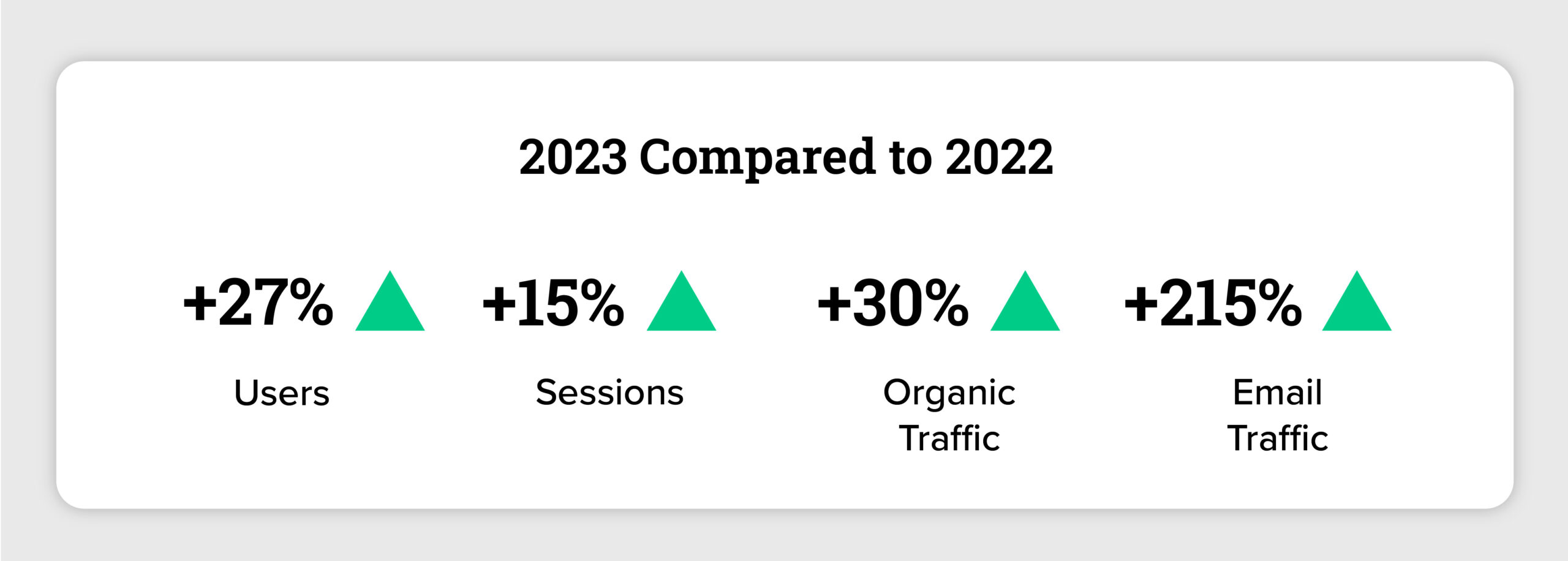What happens when you stop blogging (the impacts on your business)
By: Ash Larizza
February 7, 2024 | Reading Time: 7 mins
As a B2B-focused agency, we spend a lot of time encouraging folks to invest in regularly blogging and creating content because it’s vital to their digital marketing efforts. We’ve already talked loads about the benefits of content and why you should stop making excuses and prioritize creating a system for crafting content regularly. TL;DR: if you want to bring traffic to your site (isn’t that what we all want?), then you best be blogging.
But what happens when you don’t blog—or, when you decide to stop?
In 2022, we stopped blogging. Dun Dun Duuuuuun.
In early 2022, our team was at capacity. We shifted our focus to primarily servicing our clients and scaled back on internal efforts like Stryve’s own marketing. This meant no blogging, no social media, no email marketing.
We figured this was the best decision for our business and that it made sense to de-prioritize our marketing efforts so we could focus on the billable portion of our business. Makes sense, right?

Here’s what happened when we stopped blogging
Website traffic went down

For the first time ever, our website traffic decreased year over year. Users and sessions went down. Organic traffic dropped. Email traffic plummeted, since, duh, we weren’t sending emails because we had no blogs to include in our newsletter. It felt like people forgot that we existed.
Our other digital channels went quiet
Stopping blogging had a negative ripple effect on all our digital marketing efforts. Without new content being published, we had much less to post about on social media and include in our newsletters. This made us miss out on a year of connecting with our audiences across those digital platforms and led to fewer leads coming in from those channels. Our subscriber count still grew, thanks to some evergreen content, but we gained 7% fewer subscribers than we did in 2021.
Our sales pipeline volume decreased
With no consistent content being published, fewer contacts came into our pipeline through organic and referral sources. We still had leads come into our pipeline, but they weren’t as relevant to our business:
- Previously when we blogged, 65% of leads were high quality.
- When we stopped blogging, only 21% of leads were considered an opportunity worth pursuing.
This confirmed to us how important blogging was for brand awareness and driving relevant traffic to our website. Also, in 2021, we managed to convert 45% of our leads into customers. In 2022, this number drastically dropped to 23%. These are some huge differences and we felt them in our other departments like business development.
Our team wasn’t fulfilled
We’re a creative bunch and our internal marketing for Stryve has always been a sandbox for us to try new things with few boundaries. We love what we do and who we work with but with specific goals, brand guidelines, or tone we understandably have to adhere to certain boxes with our clients. Over the years, we found that Stryve’s marketing became an outlet for our team to have fun, experiment, take risks, and be free to explore things that we don’t have the opportunity to do on projects. Our content production was a place for professional growth and advancement.
When we stopped blogging, our team felt less fulfilled. We no longer had the space carved out to research and talk about things we found interesting or, scratch our curious itches. This also meant we had less variety in our weeks. Not only were there quantifiable business implications when we stopped blogging but there were also qualitative ones related to our team’s satisfaction.
We re-prioritized content ASAP
By the end of 2022, we re-introduced a sustainable content schedule. We stuck to it throughout 2023 and plan to continue sticking to it. The difference between 2022 and 2023 is astounding.

The numbers speak for themselves. Along with those mighty fine improvements, blog pageviews increased by 700%, conversions increased by 46%, and engagement rate increased by 8%. Wow!
Our pipeline improved as well. Sixty-five percent of leads that came in were considered opportunities worth pursuing and 33% became new clients. Our leads were way more valuable than in 2022, and we were able to reach the clients that were aligned with our goals as a company.

At the end of the day, the main takeaway from all this is that consistent blogging does wonders for your business—and that’s a common goal that we all share. Whether you want to nurture potential leads, encourage form fills, share thought leadership, or just get your brand out there, getting folks to your site is the common denominator in all these goals. It’s an ongoing investment that helps you get the most ROI from one of your business’s biggest assets—your website.
Tips to blog consistently
Identify what’s a reasonable and sustainable time commitment for your team
Determining your cadence is completely up to you. At one point, we were committed to publishing a blog every week! We realized that put a lot of pressure on our team who all had responsibilities beyond blogging. We sometimes struggled to deliver quality because we needed to pump things out quickly. When re-prioritizing blogging, we decided a bi-weekly commitment was much more sustainable for our team. While we halved the number of blogs we created every year, we used the extra time to increase their quality and comprehensiveness.
Create a process that facilitates writing
Blogging can feel daunting. Facilitating writing can put you on the path of consistency. Our team sometimes unsure about where to start. So, we introduced a content brief for everyone to fill out first before they get to writing. The content brief structures people’s thinking and holds their hand in the initial planning phases of writing. We found that investing in that early pre-writing phase with a content brief helped our team scope out their topic, think about their audience and create outlines. We became more collaborative and process-oriented. Our content team reviews the briefs and provides feedback to make the writing and review phase easier.
We also keep an ongoing list of blog topics and encourage our team to contribute or refer to the bank for ideas. If anyone needs help determining direction, they can drop into our bi-weekly content meeting for office hours with the rest of the team.
Write about what you do, what you know, what you’ve learned, what’s new
Like our audience, we’re nerds about marketing, design, and work culture—so we blog about it. You’re nerds about…well whatever it is you spend your days working on. So, talk about it. It may seem daunting or time-consuming, but if you’re talking about something you already know a lot about, you’ll find the words start flowing quicker than you anticipated. Your content doesn’t even need to be directly related to your product or service for your audience to be interested. Think about your industry and what your audience may be curious about and find the sweet spot where that overlaps with your curiosities.
You’re experts in your industry. You should share what you know with the world.
“Blogging” is more than just writing articles
Traditional blogging, aka publishing a written article is just scratching the surface of what content can be.
Video has become and stayed the most popular form of consuming content—be it long or short form. Don’t like writing much? Share something you’re an expert about in front of a camera and edit it down into a video essay.
Do you have lots of smart, future-forward people in your network? Get them to talk about it on a podcast (like our genius friends at Daggerwing Group have done). You can even switch up the structure of a written article, creating how-to guides, downloadable content, or op-eds.
No need to reinvent the wheel
If you struggle to commit to a cadence of net new content then consider alternatives.
If you’ve been blogging for a while or have a nice backlog built up, a great way to keep the engine running is to refresh old content. Take a look at some of your older published pieces and see if any of them could use an update based on how things have changed over time or new things you’ve learned.
Slowing down on the creation of new blog content but still want to feed your other channels? Try repurposing your existing content for distribution in different formats. Take our blog on WebOps which we turned into a slide deck for Instagram and LinkedIn. These posts led folks back to the original blog post (and brought more traffic to our site). It’s an overlooked method of ensuring you are taking advantage of your existing blog content. You don’t always have to do something completely from scratch.
The proof is in the pudding blog
We’ve seen first-hand how regular content production can boost results and how a lack of content can slow them. Blogging and content creation are a big time investment. But they’re worth investing in.
A blog is not just a blog. It’s a reason to connect with your audience on social media. It’s content to include in a monthly newsletter, use in paid ad campaigns, or refer to during a client pitch. It’s providing value to your audience. It proves that you’re an expert in your industry and that you provide a great product or service. Most importantly, it gets the right people to your website and keeps you on their minds.








Content Marketing
Disable the comments on your B2B website
By: Ryan Burgio